Technologies
Apple Watch Series 9 vs. Ultra 2: Don’t Get the Wrong One
After a month wearing both, this one is still on my wrist.
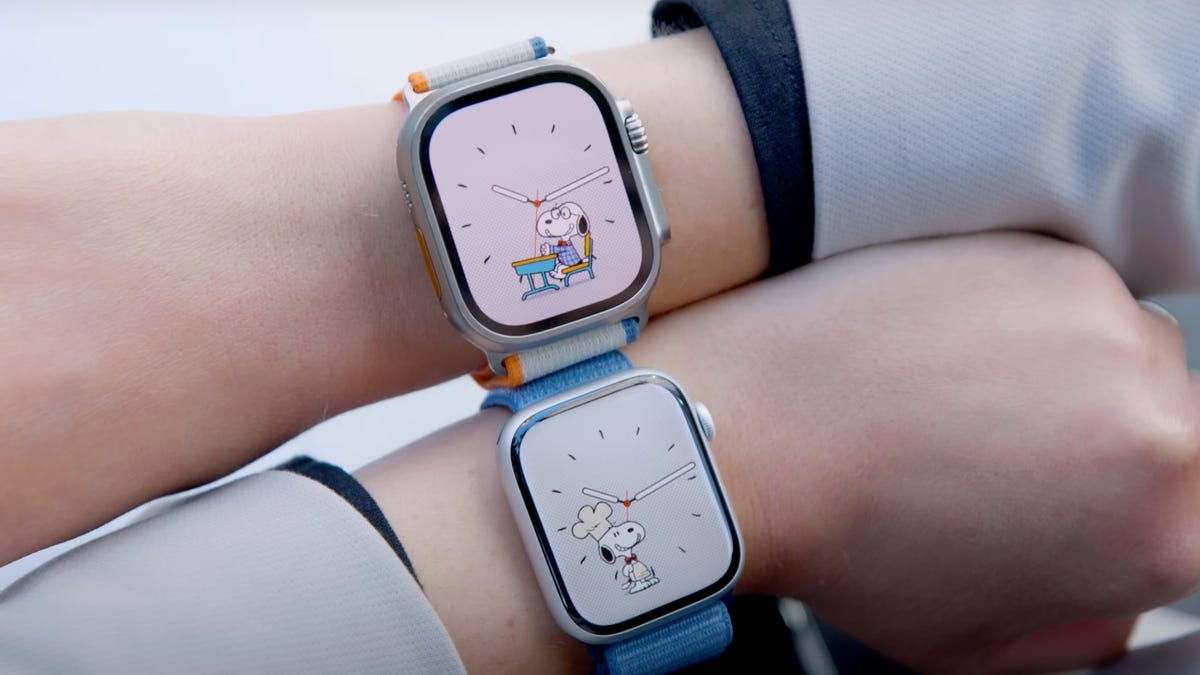
The Apple Watch Series 9 and Apple Watch Ultra 2 have more in common than you might realize, even though they’re very different watches on the outside. While the $799 Ultra 2 is a tougher, bigger and pricier watch than the $399 Series 9, internally they’re almost the same. They share the same S9 chip that supports features like Double Tap, on-device Siri and speedy performance.
So how do you separate the two? Price is likely your first consideration. The $799 Ultra 2 only comes in one 49mm size with a titanium case and LTE connectivity is included.
But the $399 Series 9 is more complicated. First, you need to choose between a 41mm or 45mm size. Then, pick an aluminum or stainless steel case and whether or not you want the LTE version. Indeed, the 45mm Series 9 in stainless steel costs $749, which puts it squarely in the ballpark of the Ultra 2.
The price factor might not be as clear-cut as you first thought. To help you make the right decision, I wore both watches for a month. Here’s what I found.
Apple Watch Ultra 2 Screen: Bigger, brighter than Series 9
The Apple Watch Ultra 2’s 49mm case is bigger than the 45mm Series 9, but the screen itself is also slightly larger. That means you can fit slightly more on the Ultra 2’s screen, helpful if you are using an app like Maps for example.
The easiest way to spot the size difference is to boost the text size to the maximum on both watches. Part of the text gets cut off on the Series 9 compared to the Ultra 2, like in the image below.

But the biggest difference in day-to-day wear is screen brightness. The Ultra 2’s screen gets brighter than the Series 9 at 3,000 nits vs. 2,000. I’ve had zero issues seeing the Series 9 indoors or outdoors, but having a little extra brightness on the Ultra 2 is nice for readability, especially for workouts in bright sunlight.
It also gives the flashlight a boost. You can turn the digital crown on the Ultra 2 to force the screen to its brightest setting when using the flashlight, which is helpful in dark situations. I went spelunking with the first Apple Watch Ultra, which shares the same screen brightness as the Series 9, and the Ultra 2. The additional brightness on the Ultra 2 really did make a difference when illuminating the rock face.
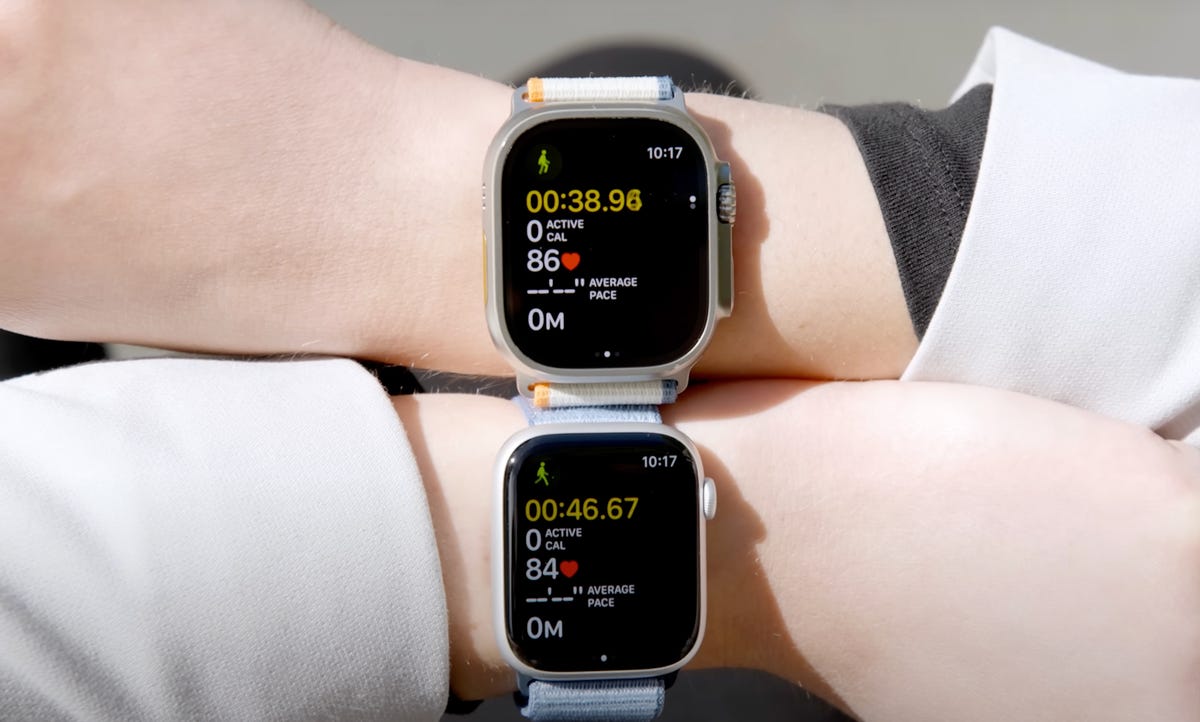
Apple Watch Series 9 might be better for smaller wrists
There’s no ignoring that the Ultra 2 is a large watch. Coupled with the chunkier digital crown and flat display, it stands out a lot more than the Series 9. My wrist measures 152mm and even though the Ultra 2 looks hefty, it’s surprisingly comfortable on a small wrist and I wear it all the time.
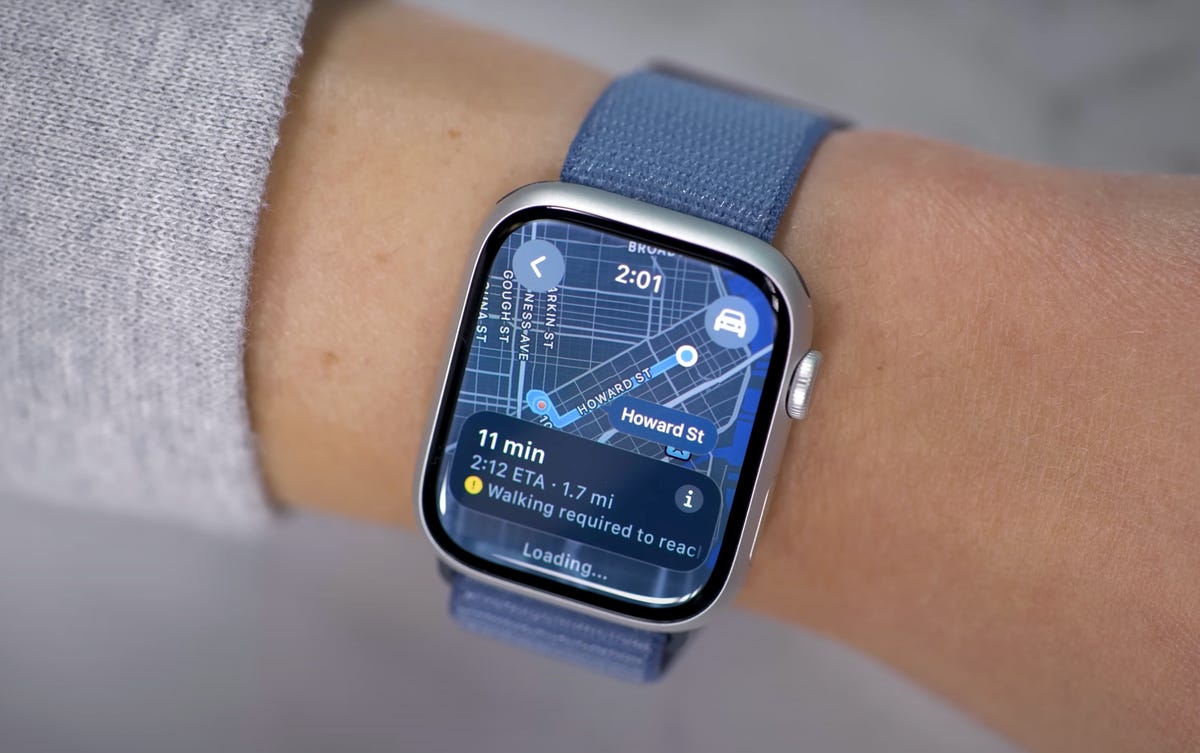
But there’s no ignoring the fact that the Ultra 2 might be too large if you have an even smaller wrist than mine. That means you might gravitate toward the Series 9 just to have the option of a smaller case size. I also found the Series 9 is more comfortable to sleep with if I do want to track my time in bed.
The Ultra 2 is, however, designed to be a tougher watch than the Series 9. Its titanium case is slightly raised to give more edge protection to the sapphire crystal display. The Series 9 display has two different coverings: Ion-X glass if you get the aluminum case, or sapphire crystal on the stainless steel case
Both are IP6X dust-resistant and water-resistant, but the Ultra 2 can go down to a depth of 100m compared to 50m. It also has an exclusive Depth app and support for the Oceanic Plus app that turns the watch into a dive computer.
Apple Watch Ultra 2 Action button speaks my love language
The Ultra 2 has another significant design feature that sets it apart from the Series 9. Just like the Action button on the iPhone 15 Pro and Pro Max, you can press it to quickly launch your favorite workout, the flashlight, the stopwatch and other preset tasks.

My favorite way to use the Action button is to trigger a Shortcut, which is a quick way of accessing a favorite feature or tasks in an app. You can program a Shortcut yourself using the app of the same name on the iPhone.
One of my top Shortcuts is to navigate home from my current location, but you could also use it to control connected home appliances, or toggle on a focus mode. The possibilities are almost endless. I even made a Shortcut to Rickroll myself (yes, seriously). You can see that in action on the video on this page.
All is not lost on the Series 9 if you like Shortcuts. You can still set a complication on the watch face to launch a Shortcut, it just requires an extra tap on the screen to confirm you want to run it.
Both Apple Watch Ultra 2 and Series 9 have Double Tap and Siri
You can use the Double Tap gesture to control both the Apple Watch Series 9 and Ultra 2. It’s powered by the S9 chip and works exactly the same on both watches. When the screen is active, you can double tap your thumb and forefinger to complete a task, rather than touch the screen. For example, raise your wrist and double tap your thumb and forefinger to reply to a message with dictation, then double tap to send.
It’s helpful, accurate and works in many of Apple’s apps. You can answer a call, change tracks and start or stop timers. For third party apps, it will generally perform the default action when you double tap. I use it to quickly reply to Slack messages from colleagues when I’m unable to grab my phone or type a response out at my computer.
It works the same on both watches, because they run the same chip. On-device Siri is also the same, so the watches don’t have to ping the cloud when you ask Siri to do something that doesn’t require the internet. That includes tasks like starting a workout or setting a timer. They also both have 64GB of internal storage, great if you like to put music or have lots of apps on your watch.
Apple Watch Ultra 2 has some special tricks
While you’ll get the same great WatchOS 10 experience and a wide selection of apps on both watches, the Ultra 2 has additional features that swing the pendulum in its favor.

First, watch faces. You might not think this is enough to make you choose the Ultra 2 over the Series 9 but the exclusive faces are nice: Modular Ultra and Wayfinder. They fit a lot of detail on the screen and have room for seven or eight complications, respectively. And they have a dark mode that turns either watch face red when the light sensor detects it’s dark outside.
The Ultra 2 also has a three-mic array to help cut out more wind noise when on calls, plus dual speakers which get louder than the Series 9. I took both watches outside and recorded the call audio so you can hear the difference on the video on this page.
Then there’s the matter of connectivity. The Ultra 2 has LTE as standard, whereas you need to buy the specific LTE (or cellular) version of the Series 9 if you want to use your watch without your phone nearby. Once you add a data plan from your existing wireless provider, you can leave the iPhone behind and still connect to your favorite apps, send messages or make calls from your wrist.
Both have the second-gen ultrawideband chip which means you can find your phone from the watch with precision finding, as long as you have an iPhone 15. If you have an older iPhone, ping your phone from your watch to make it ring.
Apple Watch Series 9 and Ultra 2 have very similar health tracking
Both share a temperature sensor, blood oxygen sensor, ECG or electrocardiogram app, as well as the option for high and low heart rate and irregular heart rhythm alerts. The heart rate sensor is also the same on both watches and accurate when compared to a chest strap.
Fitness tracking is identical and you keep track of your progress using the Apple Watch Activity app. You can also connect Bluetooth accessories like power meter pedals to both watches, create multisport workouts, and keep an eye on your heart rate zones.
A compass app, back track and waypoint functionality is standard on both watches, as well as car-crash detection, fall detection and emergency SOS.
The differences come down to the Ultra 2’s 86dB siren for safety and GPS. The Ultra 2 uses dual-band GPS, both L1 and L5 bands, while the Series 9 uses L1. That means the Ultra 2 is more accurate at tracking distance and route information in built-up areas specifically. But for regular outdoor use for runs in the park or tracking a bike ride on the trails, the Series 9 still does a great job.
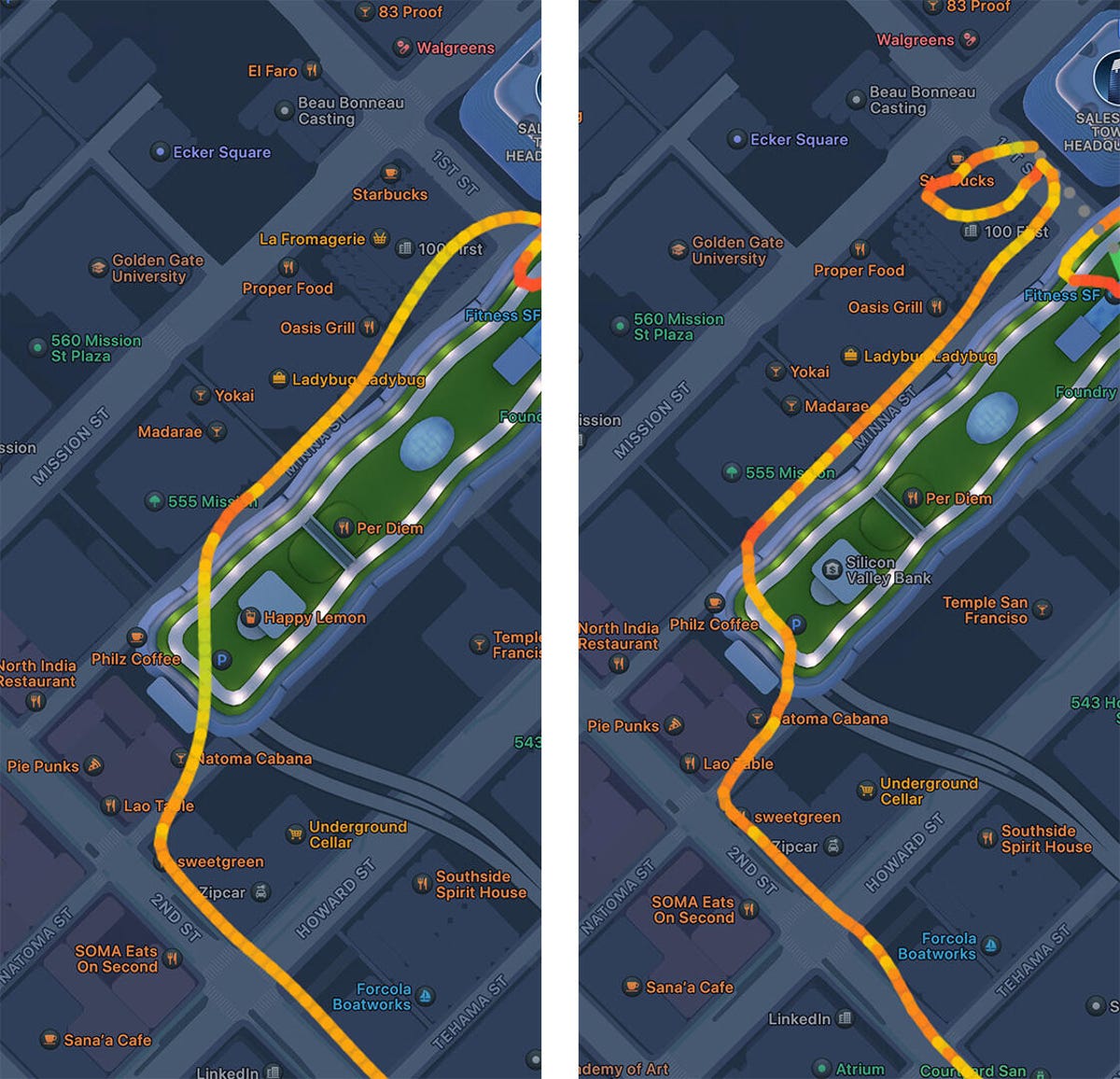
Apple Watch Ultra 2 has the best battery life, period
The Ultra 2 knocks the Series 9 out of the park on battery life. It doesn’t matter how you use the watch, whether you’re running a marathon or just using it as a watch to tell the time and get notifications, it runs rings around the Series 9.
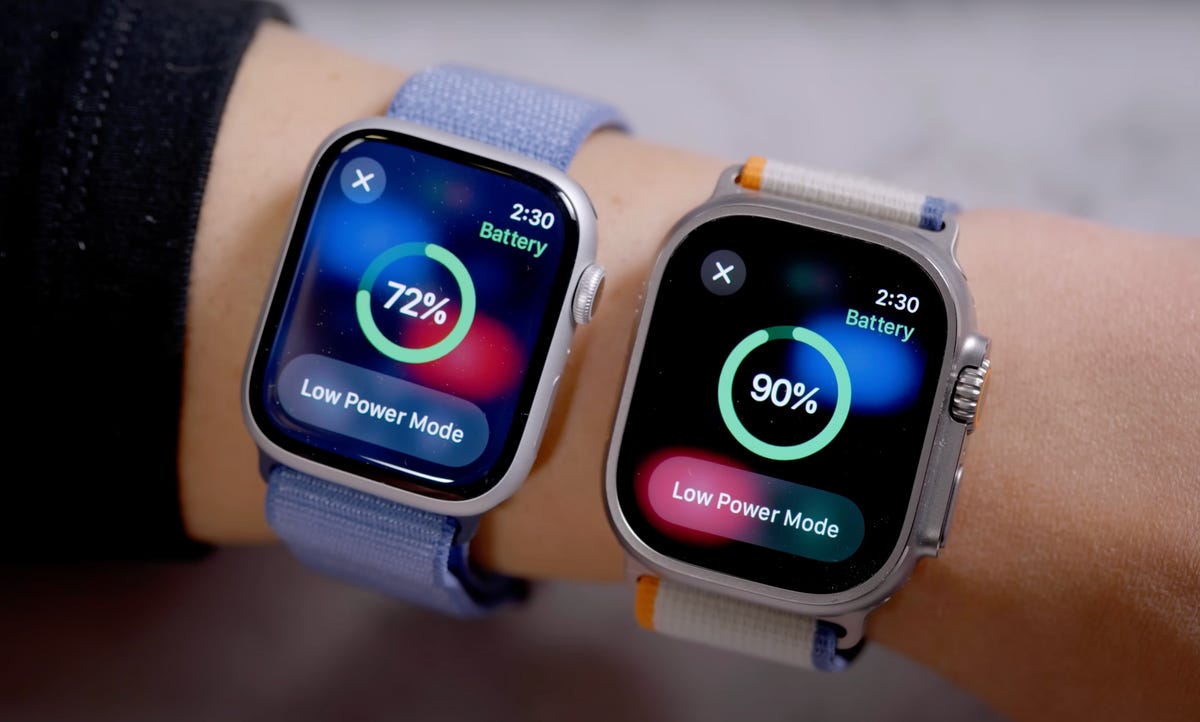
Apple officially rates the Series 9 at 18 hours and the Ultra 2 at 36 hours or runtime. But this is conservative, because I’ve been able to stretch both a lot longer. With what I’d call regular use (phone notifications, the always-on display, a GPS workout and sleep tracking) you can get a day and a half from the Series 9 before charging. With the same use, I can get closer to three full days from the Ultra 2.
Both have a low power mode to extend the battery even further, but of course your mileage will vary depending on how you use the watch. Resource-intensive tasks like using LTE and listening to music over Bluetooth will deplete your battery sooner. We have more on specific battery life usage in our Apple Watch Series 9 and Ultra 2 reviews.
Both also support fast wireless charging, as long as you have an 18-watt or higher adapter. The Series 9 charges faster than the Ultra 2 from flat to full because it has a smaller capacity battery.
What’s the difference between Apple Watch Series 9 and Ultra 2?
With a similar overall feature set, including Double Tap and on-device Siri, the main differences between the Apple Watch Series 9 and Ultra 2 comes down to size, price and battery life. The Series 9 is less expensive, has a slimmer design and two size options compared to the Ultra 2. But you will need to charge it more often.
Both Apple Watches are a great pick if you want a versatile smartwatch that works with the iPhone. After wearing both for a month, the Apple Watch Ultra 2 is my favorite for two main reasons, if price wasn’t my primary consideration. Its long battery life means I no longer have battery anxiety about needing to charge it every day. And the Action button is so helpful and customizable, it makes using the watch much more enjoyable and convenient.
Technologies
Today’s NYT Strands Hints, Answers and Help for Dec. 5 #642
Here are hints and answers for the NYT Strands puzzle for Dec. 5, No. 642.
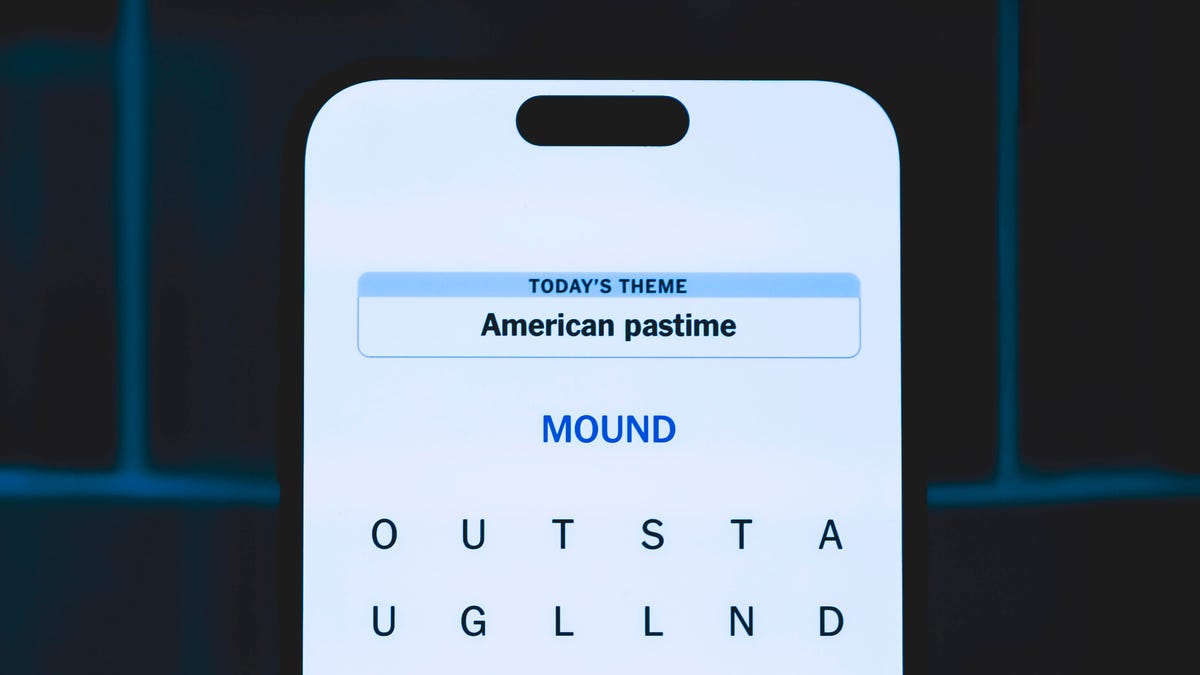
Looking for the most recent Strands answer? Click here for our daily Strands hints, as well as our daily answers and hints for The New York Times Mini Crossword, Wordle, Connections and Connections: Sports Edition puzzles.
Today’s NYT Strands puzzle is a fun one, and the theme is interesting. Some of the answers are difficult to unscramble, so if you need hints and answers, read on.
I go into depth about the rules for Strands in this story.
If you’re looking for today’s Wordle, Connections and Mini Crossword answers, you can visit CNET’s NYT puzzle hints page.
Read more: NYT Connections Turns 1: These Are the 5 Toughest Puzzles So Far
Hint for today’s Strands puzzle
Today’s Strands theme is: Feeling peckish?
If that doesn’t help you, here’s a clue: Can I see a menu?
Clue words to unlock in-game hints
Your goal is to find hidden words that fit the puzzle’s theme. If you’re stuck, find any words you can. Every time you find three words of four letters or more, Strands will reveal one of the theme words. These are the words I used to get those hints but any words of four or more letters that you find will work:
- BAKE, BAKER, BONE, BONES, SIRS, FUNS, FACT, BUTT, DIET, DIETS, GREW, STEW, GOUT, DINE, NEST, NETS, TEAK
Answers for today’s Strands puzzle
These are the answers that tie into the theme. The goal of the puzzle is to find them all, including the spangram, a theme word that reaches from one side of the puzzle to the other. When you have all of them (I originally thought there were always eight but learned that the number can vary), every letter on the board will be used. Here are the nonspangram answers:
- BAKERY, CAFE, BISTRO, BUFFET, BREWERY, STEAKHOUSE
Today’s Strands spangram
Today’s Strands spangram is DININGOUT. To find it, start with the D that is three letters to the right on the top row, and wind down.
Don’t miss any of our unbiased tech content and lab-based reviews. Add CNET as a preferred Google source.
Technologies
Today’s NYT Mini Crossword Answers for Friday, Dec. 5
Here are the answers for The New York Times Mini Crossword for Dec. 5.

Looking for the most recent Mini Crossword answer? Click here for today’s Mini Crossword hints, as well as our daily answers and hints for The New York Times Wordle, Strands, Connections and Connections: Sports Edition puzzles.
Need some help with today’s Mini Crossword? Three of the clues involve a now-infamous Gen Z/Gen Alpha joke, so you might want to have a young person nearby. Read on. And if you could use some hints and guidance for daily solving, check out our Mini Crossword tips.
If you’re looking for today’s Wordle, Connections, Connections: Sports Edition and Strands answers, you can visit CNET’s NYT puzzle hints page.
Read more: Tips and Tricks for Solving The New York Times Mini Crossword
Let’s get to those Mini Crossword clues and answers.
Mini across clues and answers
1A clue: Beaver’s building project
Answer: DAM
4A clue: Unit of distance originally equivalent to 1,000 paces
Answer: MILE
5A clue: Number of dwarfs or deadly sins
Answer: SEVEN
6A clue: Extra-large film format
Answer: IMAX
7A clue: Crosses (out)
Answer: XES
Mini down clues and answers
1D clue: Difficult-to-work-with stars
Answer: DIVAS
2D clue: U.S. soccer star ___ Morgan
Answer: ALEX
3D clue: Roughly half of the adult population
Answer: MEN
4D clue: 5-Down-5-Across, for one
Answer: MEME
5D clue: Broadway musical about the wives of Henry VIII
Answer: SIX
Don’t miss any of our unbiased tech content and lab-based reviews. Add CNET as a preferred Google source.
Technologies
The Mystery of the iPhone 17 Pro’s Missing Night Mode for Portraits
Is it a bug? Is it a technical issue? Or did Apple just yank a camera feature that wasn’t popular?
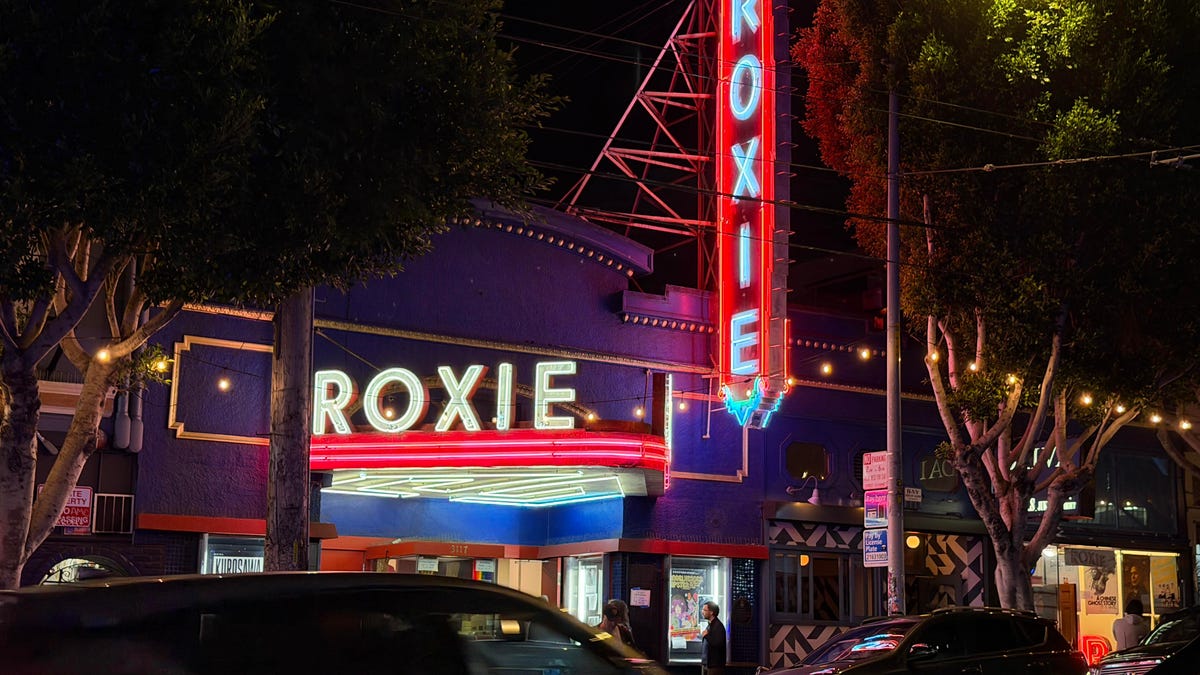
It’s a mystery. Night mode isn’t available in Portrait Mode on the iPhone 17 Pro, and no one seems to know why. Yet.
Night mode automatically brightens photos and captures more details, even in low-light conditions. You can adjust the exposure time manually. In Portrait mode, the camera focuses sharply on the subject you’re snapping and blurs the background, creating a depth-of-field effect.
The first clue that Night mode for Portrait mode was gone came from an Apple support document titled Take Night mode photos with your iPhone camera. It states what many iPhone aficionados already know: «Night mode automatically brightens photos and captures more detail in low light.»
Don’t miss any of our unbiased tech content and lab-based reviews. Add CNET as a preferred Google source.
Night mode for the iPhone 17 Pro is listed in two separate parts of the iPhone online user guide (here and also here) for selfies and time-lapse photos. But it isn’t included on the guide’s list for snapping Night mode photos in Portrait mode. The feature is still available on iPhone Pro and Pro Max on the 12, 13, 14, 15 and 16 series.
Upon investigation, CNET staffers verified that, indeed, Night mode is no longer an option in Portrait mode with the iPhone 17 Pro.
An Apple representative didn’t immediately respond to a request for comment.
When the iPhone 17 Pro was launched in September, Andrew Lanxon, CNET’s lead photographer in Europe, was impressed by the camera upgrades over the iPhone 16 Pro, including optical zoom that doubled to 8x, a telephoto camera sensor 56% larger than before and 48 megapixels of resolution.
Lanxon, a professional photographer and YouTuber, was excited to get shooting with the iPhone 17 Pro. But apparently, he will have to do without Night mode in Portrait mode.
Why did Apple do it?
Why was Night mode removed? «There doesn’t appear to be a hardware reason for it,» said CNET senior writer Jeff Carlson. «The Lidar camera that helps with low-light focusing and depth perception is still there. Perhaps it’s a software issue, but as of the iOS 26.2 release candidate, the feature isn’t present.»
Carlson found it curious that it’s taken three months since the launch of the new pro model before people noticed that it’s missing. He speculates that the feature was possibly removed because it «wasn’t being used and Apple could devote other processing resources elsewhere,» he said. «Perhaps something broke in the development of the new operating system and revamped Camera app, and it hasn’t been a high enough priority to fix in the regular release schedule.
«People have gotten used to having iPhone models that enable shots that are otherwise difficult for smartphone cameras, especially on a flagship like the iPhone 17 Pro,» Carlson said. «I hope the feature returns to give everyone the most control over the photos they capture.»
One parallel might be what Samsung did earlier this year — removing S Pen Bluetooth connectivity on the new S25 Ultra. Samsung said they removed the feature because not many people were using it. Is Apple doing the same thing with Night mode for portraits?
Some people miss it, some don’t
A subreddit on the topic appeared to be a mix of «who cares» and «oh darn.» Redditor kaoss_pad was «low key happy» that the feature had vanished, saying that «it would often surprise me and activate when I didn’t want it and ruin a moment.»
Some Redditors weren’t even aware of the feature. CultofCedar posted, «lol didn’t even notice that wasn’t a thing,» and Successful-Cover5433 wrote, «I didn’t even know you could.»
A couple of folks weren’t happy about the mysterious disappearance, including nsfdrag, who posted, «Kind of a bummer, I like the feature.»
-

 Technologies3 года ago
Technologies3 года agoTech Companies Need to Be Held Accountable for Security, Experts Say
-

 Technologies3 года ago
Technologies3 года agoBest Handheld Game Console in 2023
-

 Technologies3 года ago
Technologies3 года agoTighten Up Your VR Game With the Best Head Straps for Quest 2
-

 Technologies4 года ago
Technologies4 года agoBlack Friday 2021: The best deals on TVs, headphones, kitchenware, and more
-

 Technologies4 года ago
Technologies4 года agoVerum, Wickr and Threema: next generation secured messengers
-

 Technologies4 года ago
Technologies4 года agoGoogle to require vaccinations as Silicon Valley rethinks return-to-office policies
-

 Technologies4 года ago
Technologies4 года agoOlivia Harlan Dekker for Verum Messenger
-

 Technologies4 года ago
Technologies4 года agoiPhone 13 event: How to watch Apple’s big announcement tomorrow
